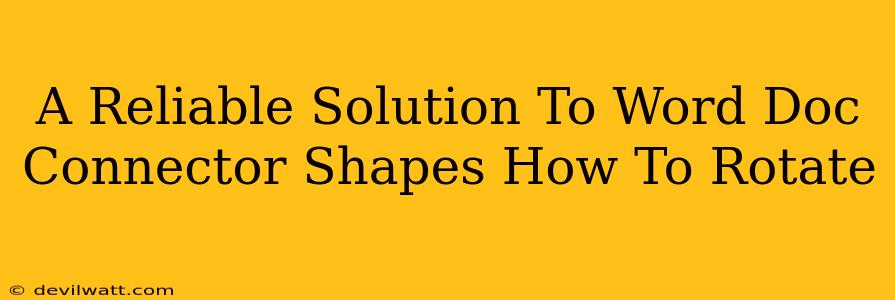Rotating connector shapes in Microsoft Word can be surprisingly tricky. Unlike regular shapes, connectors are designed to dynamically adjust their position and length, making simple rotation a bit more involved. This guide provides a reliable solution to rotating Word doc connector shapes, ensuring you achieve your desired layout with ease.
Understanding the Challenge of Rotating Word Connector Shapes
The core problem lies in the connector's inherent behavior. They're not static images; they're intelligent objects that respond to changes in the position of their linked objects. A straightforward rotation command might distort the connection or even break it entirely. Therefore, a different approach is needed.
Why Standard Rotation Fails
If you attempt to rotate a connector using the standard rotation handles, you'll often find the result unsatisfactory. The connector might twist awkwardly, detach from the connected objects, or simply not rotate as intended. This is because the rotation operation doesn't understand the connector's relationship with its linked elements.
The Reliable Solution: Rotating Connected Objects Instead
The most reliable method for rotating a connector shape and maintaining its connection is to rotate the objects it connects instead of rotating the connector directly. This preserves the integrity of the connection and gives you precise control over the final orientation.
Step-by-Step Guide:
-
Select both connected objects: Click and drag your cursor to select both objects at the ends of the connector. Hold down the Shift key to ensure both objects are selected simultaneously.
-
Group the objects (Optional but Recommended): Right-click on one of the selected objects and choose "Group" -> "Group." This groups the objects together, ensuring they rotate as a single unit.
-
Rotate the group (or objects): With the objects (or group) selected, use the rotation handle (a small circular arrow) to rotate them to your desired angle. You can also use the "Rotate" option under the "Format" tab on the ribbon.
-
Ungroup the objects (if grouped): If you grouped the objects in step 2, right-click on the group and select "Ungroup" to separate them afterward.
Troubleshooting Tips for Connector Rotation
-
Connector disappearing: If your connector disappears after rotation, check if it's hidden behind another object. You might need to adjust the layering of your objects.
-
Connector not connecting: Ensure the objects remain correctly connected after the rotation. If not, you might need to recreate the connector. Select the objects again and redraw the connector using the drawing tools.
-
Unexpected behavior: If you encounter unexpected behavior with connectors, ensure you're working with the latest version of Microsoft Word. Updates often include improvements to shape handling.
Optimizing Your Word Documents with Connectors
Mastering connector rotation is a crucial skill for creating professional-looking diagrams, flowcharts, and organizational charts in Microsoft Word. By employing the technique outlined above, you'll avoid frustrating errors and ensure your diagrams are both accurate and visually appealing. Remember, rotating the connected objects, rather than the connector itself, is the key to a seamless and reliable result.

